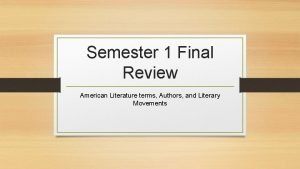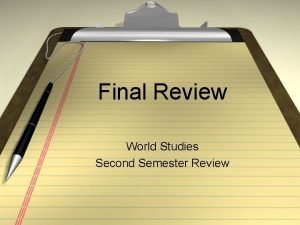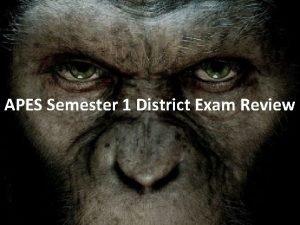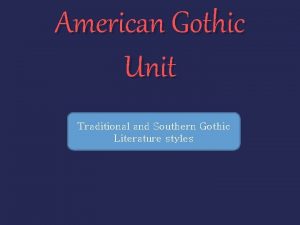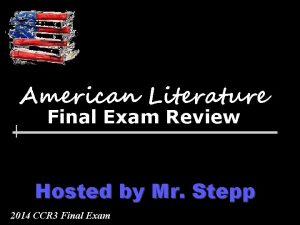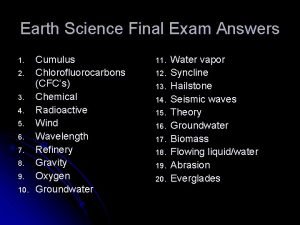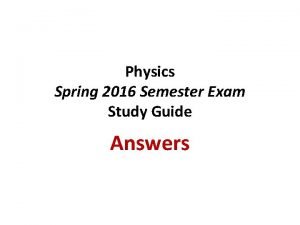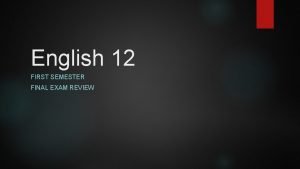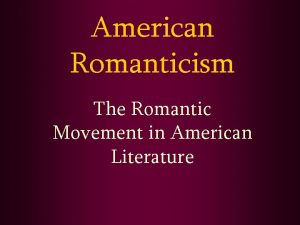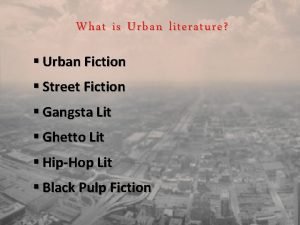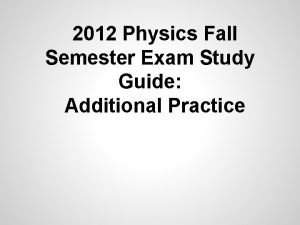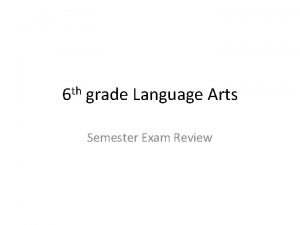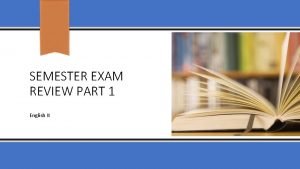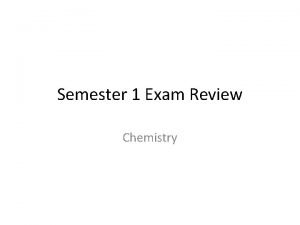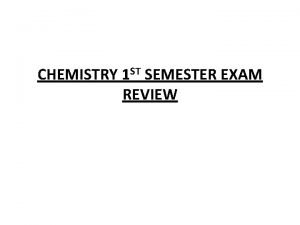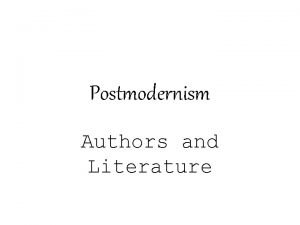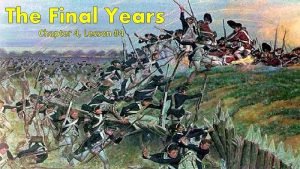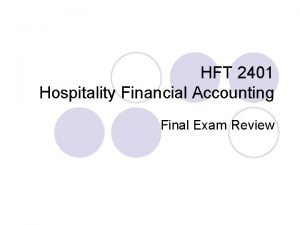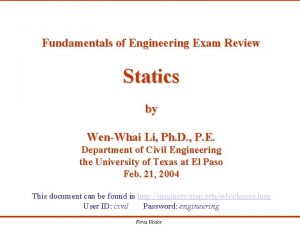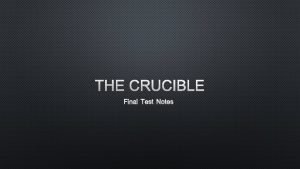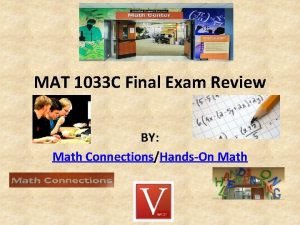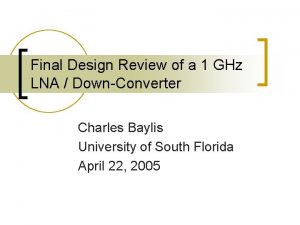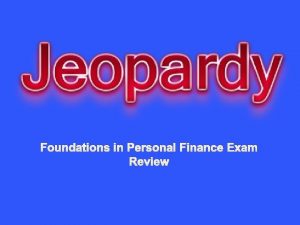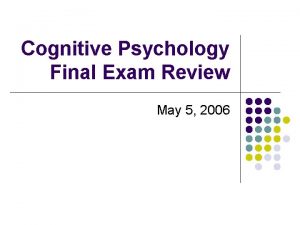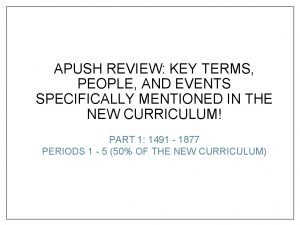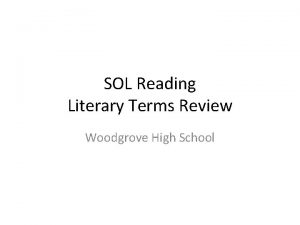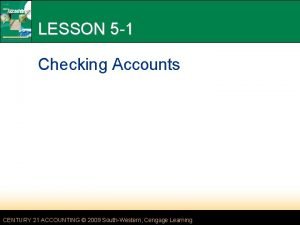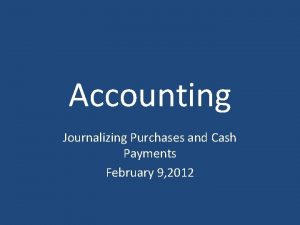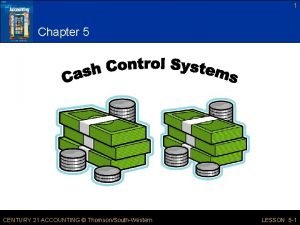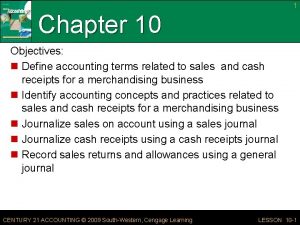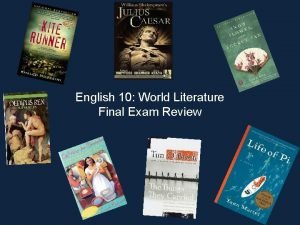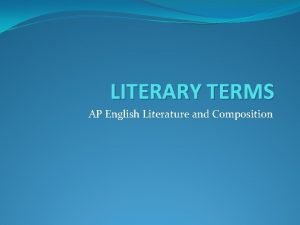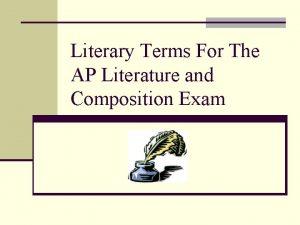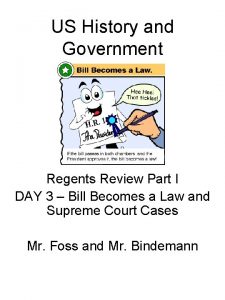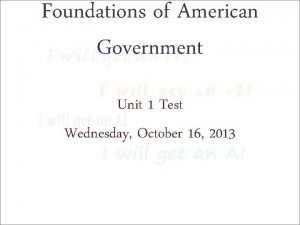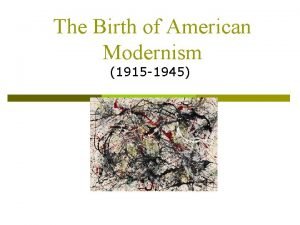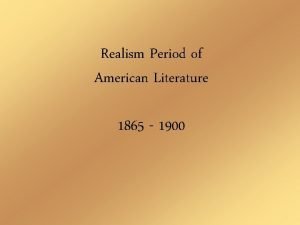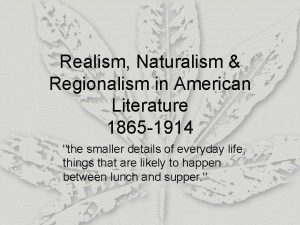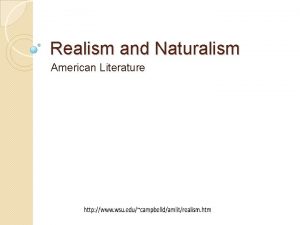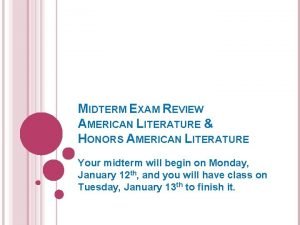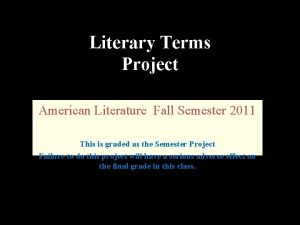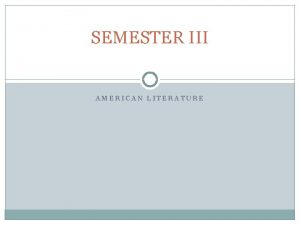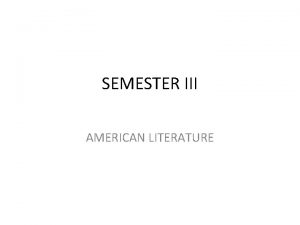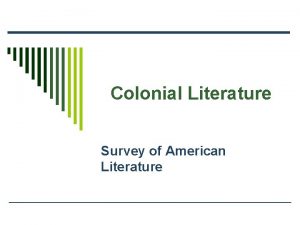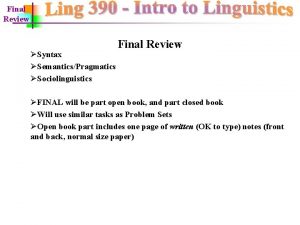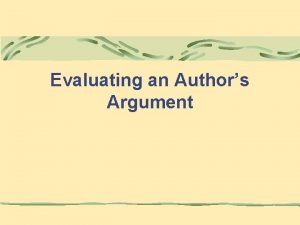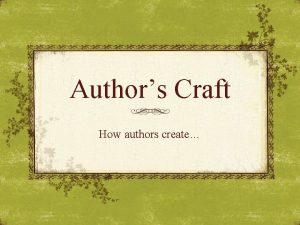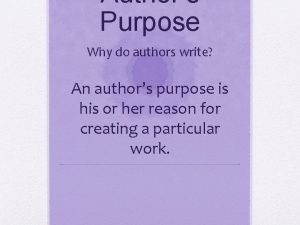Semester 1 Final Review American Literature terms Authors












































































- Slides: 76

Semester 1 Final Review American Literature terms, Authors, and Literary Movements

Answer the Following questions • When poets use words that have the same sound at the beginning. A Repetition of consonant sounds • Example "Stellar students synthesize sweet sentences. "

Answer-Alliteration!! • Becky's beagle barked and bayed, becoming bothersome for Billy.

What word represents the definition below • The writer’s attitude toward his or her audience, subject or characters. • Examples can be disgusted, frustrated, disappointed, pleased, proud, Hopeful

TONE!! • • • Example from “Song of Myself”- “I celebrate Myself, AND sing myself, And what I assume you shall assume, For every atom belonging to me as good belongs to you. Tone=Joyful

What word represents the Definition below • Words suggest and support two or more divergent interpretations • Expresses experiences or truths are complex and contradictory • Multiple meanings / Uncertain meaning

Ambiguity!! • Examples-The veil from “The Minister’s Black Veil” is never explained. We, as readers, can only infer what the veil may represent.

What word represents the definition below? • ask someone earnestly or anxiously to do something. • Begging or pleading.

Entreating!! • The commander of the regiment turned to Prince Bagration, entreating him to go back as it was too dangerous to remain where they were.

What is. . . ? • Another word for author’s message or the big, universal Idea the author is trying to convey?

Theme!! • • Examples: Loneliness can cause insanity Sacrifices are made for the good of other people Excessive amounts of greed will destroy a person and their relationships with other people • Being individualistic is the only way one will be happy

What is. . . ? • A contrast between what is stated and what is meant, or between what is expected to happen and what actually happens?

Irony!! • Situational irony-event occurs that contradicts the expectations of the characters, of the reader, or of the audience. • Verbal irony-Word or Phrase is used to suggest the opposite of its actual meaning. • Dramatic irony-contradiction between what a character knows and what the reader knows

What is. . . ? • is a symbolic narrative of how the world began and how people first came to inhabit it. While in popular usage the term myth often refers to false or fanciful stories, members of cultures often ascribe varying degrees of truth.

Creation Myths!! • • Examples”The Earth on the Turtle’s Back” “When Grizzlies Walked Upright” “Navajo Origin Legend”

What is. . . ? • “an interruption of the chronological sequence (as of a film or literary work) of an event of earlier occurrence. ” They are interruptions that writers do to insert past events, in order to provide background or context to the current events of a narrative. ”

Flashback!! • Remember “Of Plymouth Plantation? ”

What is. . . ? • The descriptive or figurative language used in literature to create word pictures for the reader. Sight, sound, taste, Touch, Smell, Movement.

Imagery!! Example: “Tom had long been picking his way cautiously through this treacherous forest; stepping from tuft to tuft of rushes and roots which afforded precarious footholds among deep sloughs; or pacing carefully, like a cat, along the prostrate trunks of trees; startled now and then by the sudden screaming of the bittern, or the quacking of a wild duck, rising on the wing from some solitary pool. ”

What is . . . ? • A literary movement among novelists at the end of the nineteenth century and during the early decades of the twentieth century. They attempted to write stories that represent actual life and ordinary characters and people in ordinary situations. They traced the effects of heredity and environment on people helpless to change their situations.

Naturalism!! • Close examples are • Death of a Salesman • “Story of an Hour”

What is. . . ? • the narrator only knows the thoughts and feelings of one character. All characters are described using pronouns, such as 'they', 'he', and 'she'. But, one character is closely followed throughout the story, and it is typically a main character.

Third person Limited Narration!! • Example- “The Minster’s Black Veil” • Mr. Hooper is followed closely while the other characters thoughts and feelings are kept at a distance.

What is. . . ? • The feeling created in the reader by a literary work?

Mood!! • Examples-A story, passage, poem, line, etc. might make you feel happy, excited, depressed, angry, or Uplifted.

What is. . . ? • hold out (something) to someone for acceptance; offer.

Proffered!! • Example in a sentence • “he proffered his resignation"

What are. . . ? • a person's principles or standards of behavior; one's judgment of what is important in life. • the regard that something is held to deserve; the importance, worth, or usefulness of something.

Values!! • Remember the values in The creation Myths and what the narrators tried to teach children and their descendants through their stories?

What is. . . ? • The use of clues to suggest events that have yet to occur.

Foreshadowing!! • Remember “The Minister’s Black Veil” and how him wearing the veil would separate him from his fiancé, society, future relationships, etc.

What are. . . ? • Rhyming sounds are similar, but not exact.

Slant Rhymes!! • • • Examples“prove/Glove” “World/Told” “Smell/Pill? “Eat/Sat”

What are. . . ? • Patterns in literature found throughout the world. These patterns may be present in characters, conflicts, themes, plot lines, settings, etc.

Archetypes!! • • • They can be found in any story, novel, play, etc. Remember the Creation Myths? The underdog The rebellious teenager The Stern father

What is. . . ? • A term that expresses the author’s attempt to Persuade, inform, or Entertain?

Author’s Purpose!! • Example • In any story or essay the author wants to persuade, or inform, or entertain the reader to do or about some subject, idea, or concept.

What is. . . ? • a seemingly absurd or self-contradictory statement or proposition that when investigated or explained may prove to be well founded or true.

Paradox!! • • • Example“The Brain is Wider than the sky” “Much madness is divinest sense” -Emily Dickinson “To be great is to be Misunderstood” -Ralph waldo Emerson

What is. . . ? • A literary movement that stressed that individualism and intuition are better guides to the truth than logic and reason. • The writers stressed individuality, a connection to nature, Man’s connection to each other, Nature represents divinity, divinity is everywhere

Transcendentalism!! • Remember Ralph Waldo Emerson, “Self-Reliance, ” Henry David Thoreau, “Civil Disobedience, ” and Walt Whitman “Song of Myself? ”

What is. . . ? • A literary movement that placed an emphasis on imagination, emotion, nature, individuality, supernatural characters, and dark imagery?

Romanticism!! • Remember “The Devil and Tom Walker” where Washington Irving is trying to tell his readers to think for themselves and not be so obsessed with material possessions and money. • He also has a lot of dark images of forests, swamps, and the devil in his story. • The supernatural character is the devil.

What is . . . ? • Another term for theme? It is the idea the author is trying to convey to his or her readers about a subject.

Author’s Message!! • Go back to theme slide to see examples of author’s messages.

What is. . . ? • A conclusion the reader has to draw from the text based off of details the author provides about a character, event, situation, conflict, etc. • A clue might be when author’s use indirect characterization.

Inference!! • Any time a reader draws a conclusion based off of something that is not directly stated in the text is an inference. • For example, as a reader one must infer what type of character Mrs. Walker is by the way she treats tom Walker.

What is. . . ? • the author's word choice, sentence structure, figurative language, and sentence arrangement all work together to establish mood, images, and meaning in the text.

Author’s Style!! • Walt Whitman has long sentences with common words to suit an audience that represents the common man. • Emily Dickinson writes short poems with slant/rhymes, dashes, and uncommon capitalization to illustrate her rebellious attitude and personality.

What is. . . ? • words placed between words, phrases, clauses, or sentences of equal rank. Also known as FANBOYS.

Coordinating conjunctions!! • For, And, Nor, But, or, Yet, and So

What is. . . ? • A general truth or observation about life. Usually, it is a short statement.

Aphorisms!! • • • Remember “Self-Reliance” Imitation is suicide To be Great is to be Misunderstood Envy is ignorance Trust thyself

What is. . . ? • A comparison made between two things without using like or as.

Metaphor!! Examples"I'm drowning in a sea of grief. “ "She was fishing for compliments. "

What is a. . . ? • Repetition of vowel sounds?

Assonance!! “Behind Me -- dips Eternity –”—Repetition of “e” sound -Emily Dickinson "Seeming of a demon's" --Repetition of “E” sound -Edgar Allan Poe

What is. . . ? • A group of lines in a poem that are considered to be a unit?

Stanza!! • We wear the mask that grins and lies, • It hides our cheeks and shades our eyes, — • This debt we pay to human guile; • With torn and bleeding hearts we smile, • And mouth with myriad subtleties. • --This is a Five line stanza that starts of Paul Laurence Dunbar’s poem “We Wear the Mask!”

What is. . . ? • A term used in which a nonhuman subject is given human characteristics?

Personification!! • Example • “The Sun smiled”

What is. . . ? • express the meaning of (the writer or speaker or something written or spoken) using different words, especially to achieve greater clarity.

Paraphrase!!

What is. . . ? • a person, plant, or animal that is descended from a particular ancestor.

Descendant!! • The rebellious daughter is the descendant of the Chief of the Sky spirit in “When Grizzlies Walked Upright. ”

What is. . . ? • a person, typically one more remote than a grandparent, from whom one is descended.

Ancestor!! • Native American ancestors told creation stories to their family member so their descendants would learn the important values of their tribes.

What is. . . ? • a brief statement or account of the main points of something. Recording large amounts of information in a brief statement or short paragraph.

Summary!!

What is. . . ? • is a point of view (who is telling a story) where the story is narrated by one character at a time. This character may be speaking about him or herself or sharing events that he or she is experiencing.

First person point of view!! • Remember “Because I could Not stop for Death” by Emily Dickinson?

What is. . . ? • a figure of speech involving the comparison of one thing with another thing of a different kind, used to make a description more emphatic or vivid using like or as.

Simile!! • He ran like a Tiger. • His car is as fast as a Jet airplane.

What is. . . ? • is a method of storytelling in which the narrator knows the thoughts and feelings of all of the characters in the story.

rd 3 person Omniscient point of View!!

Congratulations!! • You have completed the first semester Review Guide/Game for English 10 and Honors English 10 • Good Luck on the final!!!
 American literature semester 1 final
American literature semester 1 final Us history semester 2 review
Us history semester 2 review World history semester 2 final review packet
World history semester 2 final review packet World history regular semester 1 review
World history regular semester 1 review Algebra 1 final review packet
Algebra 1 final review packet Apes semester 1 final exam
Apes semester 1 final exam World history 1st semester final review answers
World history 1st semester final review answers American gothic poetry
American gothic poetry American literature final exam
American literature final exam Uncontrollable spending ap gov
Uncontrollable spending ap gov U.s. history final exam semester 2
U.s. history final exam semester 2 English 11 first semester exam
English 11 first semester exam Biology second semester final exam answers
Biology second semester final exam answers Earth science semester 2 final exam answers
Earth science semester 2 final exam answers Spanish 1 review packet answer key
Spanish 1 review packet answer key Physics semester 1 final exam study guide answers
Physics semester 1 final exam study guide answers English 12 semester 1 exam
English 12 semester 1 exam Chemistry fall semester exam review answers
Chemistry fall semester exam review answers American romantic movement
American romantic movement What is urban fiction
What is urban fiction Chemistry semester 2 review unit 12 thermochemistry
Chemistry semester 2 review unit 12 thermochemistry Honors physics semester 1 review
Honors physics semester 1 review Zoology semester 1 exam review answers
Zoology semester 1 exam review answers Geometry unit 5 review
Geometry unit 5 review Physics fall semester review answers
Physics fall semester review answers English 3 fall semester exam review
English 3 fall semester exam review English 3 fall semester exam review
English 3 fall semester exam review Chemistry semester 1 exam study guide answers
Chemistry semester 1 exam study guide answers Biology semester 1 review 2018
Biology semester 1 review 2018 Chemistry first semester exam review
Chemistry first semester exam review Postmodernist authors
Postmodernist authors Like terms and unlike terms in polynomials
Like terms and unlike terms in polynomials Unlike terms
Unlike terms The american revolution lesson 4 the final years
The american revolution lesson 4 the final years World history spring final exam review answers
World history spring final exam review answers World geography spring final review
World geography spring final review Pltw human body systems final exam review
Pltw human body systems final exam review Poe practice test - materials answer key
Poe practice test - materials answer key Ied final exam review
Ied final exam review Entrepreneurship 1 final exam review
Entrepreneurship 1 final exam review Spanish 2 final exam review packet
Spanish 2 final exam review packet Earth science final exam review
Earth science final exam review Ap world history jeopardy review game
Ap world history jeopardy review game Geometry final review
Geometry final review Physics fall final exam review
Physics fall final exam review Financial accounting final exam multiple choice
Financial accounting final exam multiple choice Statics final review
Statics final review The crucible final test
The crucible final test Physical science final exam study guide
Physical science final exam study guide Mat1033 final exam
Mat1033 final exam Lna
Lna Earth science final exam
Earth science final exam Spanish 2 final exam review
Spanish 2 final exam review Personal finance final exam review
Personal finance final exam review Antigone open-ended questions
Antigone open-ended questions Psychology final exam review
Psychology final exam review Textile machinery apush
Textile machinery apush Allegory definition in literature
Allegory definition in literature Literary terms review game
Literary terms review game Brazing weld symbol
Brazing weld symbol Regional term
Regional term Terms review 5-1 accounting
Terms review 5-1 accounting A journal used to record only one kind of transaction.
A journal used to record only one kind of transaction. List six reasons why a bank may dishonor a check.
List six reasons why a bank may dishonor a check. Century 21 accounting answers chapter 5
Century 21 accounting answers chapter 5 Terms review 10-1 accounting
Terms review 10-1 accounting World literature in english
World literature in english Ap lit literary terms
Ap lit literary terms Ap literature terms
Ap literature terms American history regents review
American history regents review Foundations of american government unit 1 test review
Foundations of american government unit 1 test review When was the romantic period in american literature
When was the romantic period in american literature American modernist novels
American modernist novels Realism literature period
Realism literature period Realism regionalism and naturalism
Realism regionalism and naturalism Realism in american literature
Realism in american literature Realism and naturalism in american literature
Realism and naturalism in american literature
